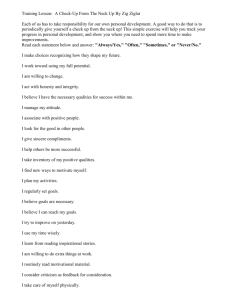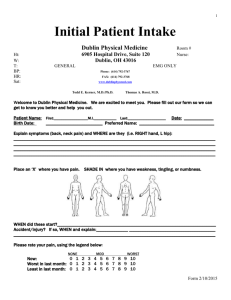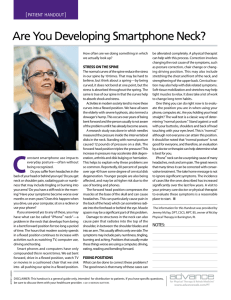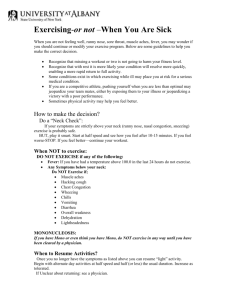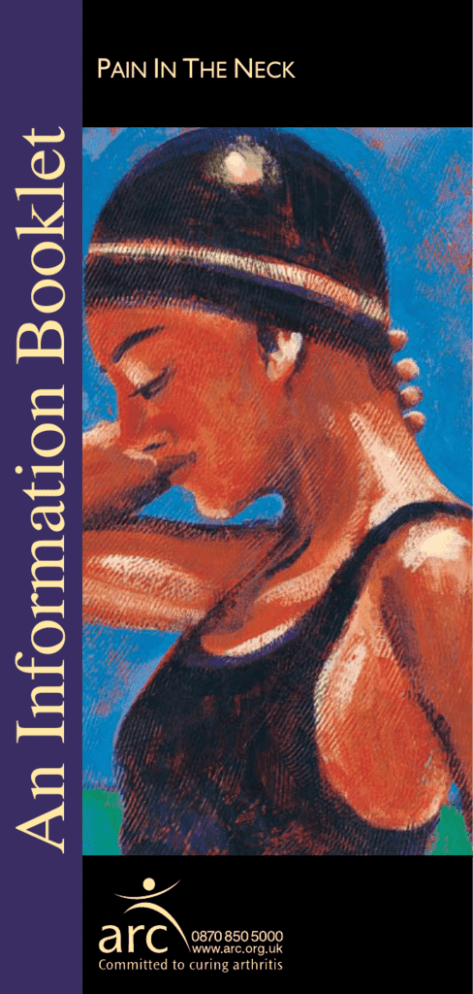
An Information Booklet
PAIN IN THE NECK
PAIN IN THE NECK
CONTENTS
2 What is in this booklet?
2 What is inside the neck?
4 What causes neck pain?
6 What are the symptoms of neck
problems?
8 Why does neck pain become
persistent?
8 How can I help myself?
11 What if the pain won’t go away?
13 What treatments are available?
14 What other help is available?
15 What research is going on?
15 Glossary
16 Useful addresses
© Arthritis Research Campaign 2004. All rights reserved.
Published November 2004
Useful addresses checked/amended: October 2006
What is in this booklet?
In this booklet we explain how the neck works and the
common causes of neck pain and related conditions. We
describe simple ways of dealing with neck pain as well
as the main medical and complementary treatments. If
you want to find out more after reading this booklet,
the organizations in the ‘Useful addresses’ section may
be helpful. Terms that appear in italics when they are
first used are explained in the glossary at the back of
the booklet.
What is inside the neck?
The neck contains the top end of the spinal column or
spine, which supports the head and also protects the
spinal cord. The spinal cord is the main nerve which
runs from the brain, through the neck and down the
back, and connects with nerves to the rest of the body.
This is shown in Figure 1.
The spine is made up of 33 bones called vertebrae
(singular: ‘vertebra’) stacked one on top of another to
form a column. The 7 bones in the neck are known
as cervical vertebrae. Between the bones are discs of
gristle (cartilage) known as intervertebral discs. The sides
of the bones are linked by facet joints. Many ligaments
and muscles are attached to the spine and fan out from
the neck to the shoulder blades and back. The muscles
control movements of your head. The spine protects the
spinal cord from outside damage while still allowing you
to move your head in any direction.
At the level of each disc, nerve roots branch out from the
spinal cord (see Figure 1), passing through an opening
in the side of the spine. The nerve roots in the neck
join to form the nerve trunks that run into the arms.
Impulses travel along these nerves, sending sensations
2
such as touch and pain to the brain and messages from
the brain to the muscles.
The vertebral artery carries blood from the heart to the
brain. It runs inside the bones of the spine and supplies
the part of the brain that controls your balance.
Skull
Spine
Spinal
cord
(passes
inside the
vertebrae)
Facet
joint
Vertebra
Disc
Nerve
roots
from
spinal
cord
to arm
Figure 1. Cross-section of the head and neck
with part of the spine shown magnified
3
What causes neck pain?
Non-specific neck pain
Many people develop a stiff and painful neck for no
obvious reason. It may happen after sitting in a draught
or after a minor twisting injury, for example while
gardening. The underlying cause for this type of neck
pain is not fully understood, so it is called ‘non-specific
neck pain’. Having non-specific neck pain does not mean
that your neck is damaged and often it happens in people
whose necks would appear completely normal under an
x-ray. It is the most common type of neck pain and often
disappears after a few days.
Cervical spondylosis
With everyday use over many years the discs and the
facet joints become worn. This wear varies from person
to person. The discs become thinner and this causes the
spaces between the vertebrae to become narrower. Also,
‘spurs’ of bone, known as osteophytes, form at the edges
of the vertebrae and the facet joints. In a way this is a
particular form of osteoarthritis (see arc booklet ‘Osteoarthritis’) but it is known as ‘cervical spondylosis’. These
changes may also occur at the bottom of the spine where
they are known as ‘lumbar spondylosis’. These conditions
should not be confused with ankylosing spondylitis,
where inflammation in the spine can cause the bones of
the spine to fuse together (see arc booklet ‘Ankylosing
Spondylitis’). The abnormalities found in cervical and
lumbar spondylosis can be seen on x-rays (see Figure 2)
and are present in almost everyone by the age of 65.
However, many people have no neck pain even though
quite significant changes can be seen on their x-rays.
When these changes do cause pain it may come either
from the linings of worn joints or from stretched ligaments. Occasionally bulging discs or osteophytes pinch
the nerve roots and this causes pain or numbness that
4
‘Spur’ of
bone
Narrowing
of disc
Figure 2. X-ray of the neck (side view)
showing cervical spondylosis
travels into the arm. If the vertebral artery is pinched,
this reduces the blood supply to the area of the brain that
controls balance and this may lead to dizziness. Rarely
an extra rib (cervical rib) can cause partial blockage of
the blood supply to the arms, resulting in pain and numbness in the hands. Very rarely, in severe spondylosis, the
spinal cord can be squeezed, which causes weakness and
numbness in the arms and legs.
‘Whiplash’
This type of injury often follows a rear-end collision in
a car. In this type of collision, first the body is carried
forward and the head flips backwards. Then, as the
body stops, the head is thrown forwards (see Figure 3).
Following a whiplash injury there is often a delay before
the pain and stiffness start.
Although whiplash can badly damage your neck, the
majority of people who suffer these shunt accidents do
not have major damage. In most cases injuries feel better
within a few weeks or months. Seat belts and properly
5
Head flips back on impact
Head thrown forward
Figure 3. Showing ‘whiplash’
adjusted headrests in cars have significantly reduced the
damage from whiplash injuries.
Tension
Most muscles of the body relax completely when they
are not being used but some muscles (known as ‘antigravity muscles’) have to work all the time in order to
keep your body upright. Muscles at the back of your neck
must always be tensed, otherwise your head would fall
forwards when you are sitting or standing. When these
muscles work too hard it can cause neck pain and tension headaches. People who are worried or under stress
often tighten their muscles more than is necessary to
hold their head upright – in other words, they are literally
‘tense’. Tension headaches are very common and are
often wrongly called migraines.
What are the symptoms of
neck problems?
Pain
You may feel pain in the middle of your neck or on one
side or the other. The pain may travel to the shoulder
and shoulder blade or to the upper chest. In tension
headaches the pain often travels to the back of the head
6
and sometimes to the side of the head and behind the eye
or even into the ear. If a nerve root is pinched, then as
well as the pain you may have numbness or tingling that
can be felt down the arm right to the fingers.
Stiffness
This is common. You may find it painful to move and
your muscles feel tight. Stiffness is often worse after
long periods of rest or after sitting in one position for
a long time. You may also have muscle spasm or, in cervical spondylosis, you may lose movement because of
the changes to the bones and discs.
Noisy joints
You may hear or feel clicking or grating (called ‘crepitus’)
as you move your head. This is caused by roughened
bony surfaces moving against each other or by ligaments
rubbing against bone. The noises are often loudest at
the top of the neck. This is a common symptom and
can be upsetting.
Dizziness and blackouts
These can sometimes happen when bony changes in
cervical spondylosis cause pinching of the vertebral
artery. You may feel dizzy when looking up, or you may
occasionally have blackouts.
Torticollis
Sometimes if you have neck pain you may also have
muscle spasms that turn the head to one side. This is
called torticollis. Although not very common, it is an
unpleasant side-effect of neck pain. It usually lasts only
a few hours or days, although rarely it may continue for
several weeks.
Other symptoms
If you have long-lasting neck pain and stiffness, particularly if your sleep is disturbed, then you may feel
excessively tired and this can cause depression.
7
Why does neck pain become
persistent?
In some cases of persistent pain the cause of the pain
(such as a facet joint or a disc) can be identified. However, it is important to realise that pain can sometimes
continue even after the original cause (whiplash, facet
or disc) has long since settled down.
Pain may at first cause you to avoid normal activities
and movement. If your initial spell of neck pain lasts a
long time, lack of activity can cause the neck muscles to
become weak, and this reduces the ability of the cervical
spine to take further knocks. You may also lose confidence
in your ability to resume your normal activities. This
may affect your work, your social life and your personal
relationships. Naturally, you may feel depressed and
anxious in this situation and this could lead to further loss
of confidence, frustration and anger, particularly if family
members and the medical profession appear unhelpful
or unsympathetic. If you are anxious or depressed as a
result of the pain, you may not feel like exercising, so your
muscles become weaker still, and so it goes on.
This can happen to anyone, and the longer it continues
the harder it will be for you to recover your movement
and confidence. The sections that follow explain what
can be done to prevent or break this cycle of pain.
How can I help myself?
Most attacks of neck pain settle down within a few days
and do not need medical treatment. Resting for a few
days is often all you need.
Painkillers
You can take simple painkillers such as paracetamol.
Non-steroidal anti-inflammatory drugs (NSAIDs) such
8
as ibuprofen, available at chemists, often help but can
sometimes cause indigestion, so be careful if you have a
history of stomach upsets. As an alternative you can rub
anti-inflammatory gels or creams onto tender areas with
less risk to the digestion.
Massage
Gentle massage of the neck muscles, particularly with
aromatic oils, often helps. Please note, however, that
some oils can be poisonous (toxic) in large quantities
and can be harmful during pregnancy or with conditions
such as epilepsy (see arc booklet ‘Complementary Therapies and Arthritis’). Rubbing the area with liniments
can also help – these produce a feeling of warmth and
reduce pain. Some liniments available over the counter
contain capsaicin (an extract of the capsicum, or pepper,
plant), and a similar but stronger preparation is available
on prescription.
Exercises
Simple exercises can help to restore your range of movement, promote strength, ease localised stiffness and help
get your neck back to normal. You should start by exercising very gently and gradually build up. You can expect
to feel some slight discomfort at first.
Figure 4 shows some simple stretching and strengthening exercises. Gently tense your neck muscles for a few
seconds in each position. If you do this every day, the
neck movements will increase your muscle strength.
Relaxation
Stress can make neck pain worse (see ‘Tension’ above).
One way of reducing the effects of stress is to learn how
to relax the neck muscles. Relaxation and exercises are
not mutually exclusive – they complement each other.
You can sometimes get audiotapes to help with relaxation from your doctor or a physiotherapist. They can
9
Figure 4. Stretching and strengthening
exercises for the neck
also be bought from the Pain Relief Foundation (see
‘Useful addresses’).
Posture
Pain and stiffness can be caused by poor standing posture or by too soft a bed or the wrong thickness of pillow. If your desk is too low, so that your head is bent
forward for long periods, then the neck may be stretched
and you may develop muscle pain. Check your desk
height and chair design at work and in the home – this
is important to prevent problems (see Figure 5). Simi10
GOOD
BAD
Figure 5. Sitting at a desk of the right height
with your chair correctly adjusted is important to avoid neck pain.
larly, if you work at a computer screen it is important to
have screen, desk and chair set at the correct heights.
Many firms employ people to check that their employees
are sitting properly – check with your line manager or
occupational health nurse.
The Alexander Technique is a method of teaching
bodily awareness and reducing unwanted muscle tension. Lessons are given by qualified teachers who will
assess you and advise you on things such as your standing
and sitting posture and your patterns of movement (see
‘Useful addresses’).
What if the pain won’t go
away?
If pain lasts for more than a few days, or if pain spreads
into the arm, then you should see your doctor (GP).
S/he will examine your neck and may arrange physical
treatments.
11
Most cases of neck pain can be confidently diagnosed
and treated without any special tests. Very occasionally
your GP may ask for an x-ray to rule out other important
causes of neck pain, such as ankylosing spondylitis or
an infection.
If your pain is very bad, or if it spreads into your arm
or you have dizzy spells, your GP may send you to see
a specialist. The specialist may be a rheumatologist, orthopaedic surgeon or neurosurgeon, depending on the
problem. Further tests may be needed, such as x-rays,
blood tests, or magnetic resonance imaging (MRI) scans
(see Figure 6). An MRI scan will only be done if there
is a suggestion that there is a nerve (or nerves) being
Base of
brain
Skull
Spinal
cord
Skin of
back of
neck
Vertebrae
Intervertebral
discs
Figure 6. MRI scan of the neck
12
pinched in the neck, and if further treatment is being
considered. A specialist may recommend injections into
certain parts of the neck (see ‘Injections’), but only once
it is clear exactly where the pain is coming from. Surgery
is very rarely needed – only in severe cases of nerve or
spinal cord involvement.
What treatments are
available?
Physical treatments
Physiotherapists, chiropractors and osteopaths are all
trained to treat neck problems. Manual treatments carried out by one of these therapists are often all that is
needed. Sometimes manipulation is uncomfortable at
the time, so it is important that you understand what is
involved. Make sure you talk to your therapist about the
treatments before they start.
Collars
There is no evidence that these are any help for shortlived or long-lived neck pain. Some people find they help
at night to keep the neck in a good position while they are
asleep. An alternative for use at night is a ‘neck pillow’,
which is a specially shaped piece of moulded foam. These
are available from good department stores.
Injections
In some cases an injection may help. The injection may
be a long-acting local anaesthetic or a steroid preparation,
and may be given into the small facet joints of the neck
or sometimes into the narrow spaces where the nerves
emerge from the spine. These injections are usually given
by a specialist (a radiologist or anaesthetist) and are performed in an x-ray department so that the specialist can
see exactly where the injection is going.
13
Surgery
Only rarely is surgery necessary. Surgery may help if a
nerve is pinched and it is causing weakness or severe
pain which won’t go away. The surgeon will ask for a
scan to look at the nerves and bones before discussing
with you the need for the operation and the pros and
cons of surgery.
Other treatments
Acupuncture can help relieve neck pain. At the moment
there is no evidence that reflexology or a change in diet
are effective.
What other help is available?
If your neck pain lasts for many months you may need
help to cope. The answer may be a pain management
programme (see below) which aims to teach you how
to control, and live with, your pain. Understandably,
people avoid situations which make their neck pain
worse, such as certain positions and activities (see ‘Why
does neck pain become persistent?’). Education, therefore, plays an important part in the pain management
approach, and will include a full explanation of the
physical and psychological factors contributing to your
pain. Most people will be able to exercise and become
fitter, although it will take longer for some than for others.
In this way people regain their physical confidence and
are able to do more in spite of their pain. Specific exercises also help to strengthen the neck muscles that have
become weak with lack of use.
Pain management programmes vary from outpatient
group sessions, usually led by physiotherapists, to residential in-patient programmes lasting 2–3 weeks. There
are only a few residential centres in the UK but there
are many non-residential centres. These programmes
include education, exercise, coping strategies and the
14
use of medication. They are led by a team including doctors, nurses and physiotherapists. Psychologists are also
usually part of the team as they can explain why you
might suffer psychological distress and how you can
cope with this.
Your doctor may be able to refer you if s/he thinks you
would benefit from a pain management programme.
What research is going on?
Many research teams throughout the world are studying
neck pain. In the UK there have been advances in our
understanding of the composition and biochemistry of
the discs. Research has also shown that a large part of
the normal wear of the spine is genetically determined
(that is, there are inherited factors).
Discoveries about the effects of pain on the functioning
of the back and neck muscles, the effect of stress and
workplace conditions, and the importance of exercises
are changing the ways in which neck pain is perceived.
Imaging techniques such as MRI allow a clearer understanding of the structure of the spine and can guide treatment, such as injections into the facet joints.
Glossary
Cartilage – strong material mainly found on bone ends
that acts as a cushion and allows the bones to move
smoothly on one another. A special type of cartilage is
found in the intervertebral discs in the spine.
Facet joint – side joint connecting two vertebral bones.
Intervertebral disc – a circle of fibrocartilage (a tough,
fibrous type of cartilage with a pulpy centre) which is
found between spinal vertebrae.
15
Ligaments – tough, fibrous bands anchoring the bones
on either side of a joint and holding the joint together.
Magnetic resonance imaging (MRI) scan – a scan
that shows up the soft-tissue structures in the neck as
well as the bones. Often used in cases of arm pain. During
an MRI scan you have to lie in a tube and it may be
unpleasant for those who suffer from claustrophobia.
Osteoarthritis – a condition which can affect any joints
in the body, in which the cartilage becomes damaged and
the bones deform. Often referred to as ‘wear-and-tear’
or ‘degenerative changes’.
Osteophytes – outgrowth of new bone around the sides
of osteoarthritic joints, also known as ‘spurs’.
Spondylosis – osteoarthritis of the small joints in the
neck and back.
Useful addresses
The Arthritis Research Campaign (arc)
PO Box 177
Chesterfield
Derbyshire S41 7TQ
Phone: 0870 850 5000
www.arc.org.uk
As well as funding research, we produce a range of free
information booklets and leaflets. Please contact the
address above for a list of titles.
Arthritis Care
18 Stephenson Way
London NW1 2HD
Phone: 020 7380 6500
Helpline (freephone): 0808 800 4050
www.arthritiscare.org.uk
Offers self-help support, a helpline service, and a range
of leaflets on arthritis.
16
British Acupuncture Council
63 Jeddo Road
London W12 9HQ
Phone: 020 8735 0400
www.acupuncture.org.uk
Publishes a full list of qualified practitioners and general
information on acupuncture.
British Chiropractic Association (BCA)
59 Castle Street
Reading
Berks RG1 7SN
Phone: 0118 950 5950
www.chiropractic-uk.co.uk
Can supply details of chiropractors in your area.
British Medical Acupuncture Society
(BMAS)
BMAS House
3 Winnington Court
Northwich
Cheshire CW8 1AQ
Phone: 01606 786782
www.medical-acupuncture.co.uk
Provides patient information and a list of practitioners
who are medical doctors.
Chartered Society of Physiotherapy
14 Bedford Row
London WC1R 4ED
Phone: 020 7306 6666
www.csp.org.uk
General Chiropractic Council (GCC)
44 Wicklow Street
London WC1X 9HL
Phone: 020 7713 5155
www.gcc-uk.org
The regulatory body for chiropractors in the UK; can
also supply details of chiropractors in your area.
17
General Osteopathic Council
176 Tower Bridge Road
London SE1 3LU
Phone: 020 7357 6655
www.osteopathy.org.uk
Can supply details of osteopaths in your area.
Institute for Complementary Medicine
(ICM)
PO Box 194
London SE16 7QZ
Phone: 020 7237 5165
www.i-c-m.org.uk
Publishes a register of complementary practitioners.
Pain Relief Foundation
Clinical Sciences Centre
University Hospital Aintree, Lower Lane
Liverpool L9 7AL
Phone: 0151 529 5820
www.painrelieffoundation.org.uk
Produces information leaflets and audiotapes. Visit the
website or send a 50p-stamped, self-addressed envelope
to the address above, specifying your particular pain
problem.
Society of Teachers of the Alexander
Technique (STAT)
1st Floor, Linton House
39–51 Highgate Rd
London NW5 1RS
Phone: 0845 230 7828
www.stat.org.uk
Can supply a free list of practitioners of the technique.
18
Arthritis Research Campaign
The Arthritis Research Campaign (arc) is the only major
UK charity funding research in universities, hospitals
and medical schools to investigate the cause and cure of
arthritis and other rheumatic diseases. We also produce
a comprehensive range of over 80 free information booklets and leaflets covering different types of arthritis and
offering practical advice to help in everyday life.
arc receives no government or NHS grants and relies
entirely on its own fundraising efforts and the generosity
of the public to support its research and education
programmes.
Arthritis Today is the quarterly magazine of arc. This will
keep you informed of the latest treatments and self-help
techniques, with articles on research, human interest
stories and fundraising news. If you would like to find
out how you can receive this magazine regularly, please
write to: Arthritis Research Campaign, Ref AT, PO Box
177, Chesterfield S41 7TQ.
Please add any comments on how
this booklet could be improved.
Feedback is very valuable to arc. However, due to the
volume of correspondence received, we regret that we
cannot respond to individual enquiries made on this
form.
Please return this form to: Arthritis Research
Campaign, PO Box 177, Chesterfield S41 7TQ
The Arthritis Research Campaign was formerly known as the Arthritis and
Rheumatism Council for Research. Registered Charity No. 207711.
6024/NECK/04-2
Information on drugs
Separate arc leaflets are available on many of the drugs
used for arthritis and related conditions. We would
recommend that you read the relevant leaflets for more
detailed information about your medication.
A team of people contributed to this booklet. The original text
was written by a doctor with expertise in the subject. It was
assessed at draft stage by doctors, allied health professionals, an
education specialist and people with arthritis. A non-medical
editor rewrote the text to make it easy to understand and an
arc medical editor is responsible for the content overall.
Cover illustration © Sara Hayward 2001. All rights reserved.
Printed on 80% recycled paper



